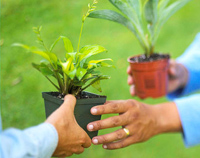What's The Solution
Is Gardening Without Peat Possible?

Of course! Peat retains water and minerals well, but many sustainable peat substitutes (peat replacement) such as leaf compost or mixtures based on coconut or wood fibers, do just as well (see our FAQs for more details). Good to know: Even the Botanical Garden Amsterdam (De Hortus), with its immense assortment of plants, manages (almost) entirely without peat!
What Can We Do About It?
We need to stop using peat. Let's differentiate.
- Peat in the hands of private gardeners is simply a waste and should be banned as soon as possible.
- Peat for ornamental plants is a convenience. Growing the seedling in peat gives reliable results, but there is no reason to fill the rest of the pot with peat. A shift to such a two-step approach is doable within a few years.
- Peat for seedlings used in precision farming will be the hardest nut to crack. The sterile nature of peat and its highly uniform characteristics bring a significant economic benefit. Replacing peat with renewable materials in the food sector will require years of careful experimentation.
Let's look at how these three user groups can contribute to a greener future.
What Can The Growing Media Industry Do?
The growing media industry is at the core of the transition to a peat-free future. They have to deliver what the market demands, but it demands 'quality' and not 'peat.' Therefore, these companies have tremendous leverage to influence the market.
1) Immediately stop using non-RPP peat (see FAQ’s about the Responsibly Produced Peat (RPP) scheme
2) Campaigning for better availability of alternative materials, e.g., fight against biomass combustion subsidies. Growing media companies can also motivate their professional customers to recycle green waste.
3) Experimentation with alternative mixtures and co-development with their customers.
4) Lead an information campaign about the sensible use of different types of soil products (e.g., potting soil vs. gardening ground).
What Can The Ornamental Sector Do?
The ornamental sector is a considerable peat consumer. In many cases, peat is used as a mere convenience. This fossil source is dirt-cheap and very lightweight so that the customers don't have to carry heavy pots.
The ornamental plant industry can do a lot to become more sustainable.
1) Labeling. Which substrates have been used for your plants? Put a sticker on the pot and provide this information online as well.
2) Plug-only: Grow your seedlings in the technically best potting soil possible, then plant this seedling into a peat-free ground.
3) Recycling: The plug-only strategy will require large amounts of alternative materials. Your work itself generates large quantities of green waste, which in turn could be used to produce potting soil. Collect it and provide it to recycling/ composting companies. Sounds trivial? We wouldn't mention this if we didn't see professional growers simply burning their green waste, producing toxic fine dust instead of growing media.
What Can The Food Sector Do?
The journey to a peat-free world will be the longest for this sector. Safety is critical: for the health of the customers who eat these products and the stability of the food supply chain.
1) Recycling of used growing media for the highest value-added application possible.
2) Differentiate between substrate types. An example: mushroom growers are significant users of peat. Some of them manage to differentiate between a top and bottom layer for their growing media. Peat and non-peat layers are separated after use and recycled accordingly.
3) Lower the peat content in the seedling plugs step by step.
What Could A Path To A Peat-Free Future Look Like?
Turfvrij.nl is promoting a multi-step approach to a peat-free future.
Immediately: Full transparency: comprehensive ingredients lists on all bags and websites where potting soil and gardening ground is sold. We also promote ingredients lists for potted plants.
Short term (until 2024): Ban on peat for private users. It's simply not necessary in most cases. The tiny quantities needed for the seedlings can easily be covered by the small but growing assortment of peat-free alternatives.
Mid-term (2024-2028): Plug-only for the professional market: peat use is limited to seedling plugs (20-50 mL per plant) as far as the availability of alternative substrates allows.
Long-term (2030): Ban on all peat-containing products.
Remarks:
1) Products that can technically not be grown without peat:
1a) Food: Exempted from the rule. However: The burden of proof is on the side of the peat user. Recycling peat is compulsory as far as technically feasible.
1b) Non-food: these products will be banned in the Netherlands from 2030. You will still enter a plant shop thinking, "Wow, how many nice plants do they have."
2) Ban needs to be enacted on the product (not production) level to ensure that domestic industry is not disadvantaged against foreign competition.